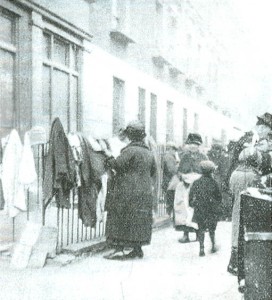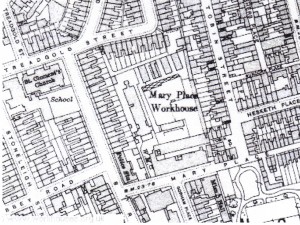NOTE: This article first appeared in the North Kensington Citizen during May 1939 and has been made available thanks to local historian Tom Vague and the Colville Community Forum.
The Rag Fair started because of the existence of the workhouse in the locality many years ago. It was held in two residential streets far from public transport. Notting Dale workhouse on the site of what is now Avondale Park Gardens was supposed to be the cruellest in London. To it were sent the difficult cases from all other workhouses and the threat to send inmates to it was an effective method of discipline to others. The cruel prison discipline, with its task work and starvation diet, drove the inmates from its doors almost as soon as they had entered it. These unhappy vagrants drifted into (a number of) the common lodging-houses which had sprung up in the two streets of Rag Fair. These lodging-houses were nothing like the few remaining lodging-houses of today.
They were more like stables and their occupants treated like cattle. Dozens of these vagrants would pay 2d a night for the privilege of sleeping in their filthy rags on bare floors. They would be packed so close together as to resemble a dirty patchwork carpet. Those who could afford 4d slept in beds of packed straw, which were packed so tightly as to convey an impression of one huge bed, covering the entire floor space of the room. These poor creatures would beg or earn a few coppers a day. Those lucky enough to get a few coppers over and above the amount necessary for their food and shelter would be on the look put for cheap second-hand clothing to replace their rags.
The First Stalls
To cater for the meagre clothing wants of these unfortunate lodging-house dwellers a couple of second-hand stalls arrived every Sunday morning and pitched outside the lodging-houses. For many years (those) rags were the only articles traded in at the Fair. Later came some second-hand furniture to be bought by the most fortunate ones who had secured some kind of work and who were planning to escape from the hell of the common lodging-house.
The infamous workhouse was closed 40 years ago. Then Notting Dale was no longer a centre for vagrants. The lodging-house owners were soon without their clients and so were compelled to close the worst of their dens. The Sunday morning stall holders too had to improve and vary their stocks to meet the different demands of different people. This process of improvement went slowly on for years but the fair still remained a local market; few people outside the immediate neighbourhood ever visited it or indeed knew of its existence.
Metropolitan Market
Immediately after the war the character of the Fair changed rapidly. From a local gathering it developed into a metropolitan market, attracting customers from all over London. In 1919 the first political meeting was held. A young, lone Labour propagandist from Hammersmith came to have a look at the Fair. He instantly decided it would make a good meeting place and he then borrowed a box for a stand and held a successful meeting.
For ten years he constantly preached at the Fair to huge congregations. The fame of his meetings quickly spread through London, so much so that the Rag Fair became known to many strangers, not through the market but through its meeting. The traders of the Fair christened this young speaker ‘Bishop of Rag Fair’ and I know he was far more pleased and honoured with that title than he was, when years later, he became well known as FR West MP for North Kensington.
He wrote a political pamphlet contrasting the wealth of Mayfair with the poverty of North Kensington. This pamphlet is titled ‘Rag Fair to Rotten Row’. For ten years after the war the Fair grew and grew until it almost rivalled Petticoat Lane. The variety of the stocks extended until it included almost everything. Auctions of all kinds were held and tipsters and medicine men vied with each other to capture the crowds and their money.
Babble of the Market
For two days each week these two normally quiet streets were drowned in the babble of a prosperous market. The tenants of the houses would often sit in groups at their wide opened windows watching the surging mass of humanity, as it pushed its way along a narrow lane in the centre of the road, between the double line of stalls. Not an inch of space was wasted in those streets. Even the front railings and front doorsteps were let to traders for 2s 6d a week. The railings covered with second-hand clothes often resembled a line of scarecrows. On the front doorsteps would be marshalled rows and rows of old boots and shoes ready for inspection. Even the deep, dark basements would be utilised as shop windows. It was indeed the heyday of Rag Fair.
In 1929 Kensington Borough Council decided that the Fair was undesirable and a little later developed its plans for closing it. It was discontinued (after 40 years) because the traders were trading without licenses. The traders informed the Council that they were quite prepared to apply for licenses but the Council replied that it had no power to grant licenses for trading on Sundays as it would be contravening the Lord’s Day Observance Act.
A year or so later all traders were warned and a little later still batches of them were fined for trading without a license. That was the beginning of the end. Gaps began to appear in the lines of stalls. There was a show of fight by some, who had the backing of many of the residents of the two streets but it only prolonged the agony. Fair, Rag Fair was doomed. The actual date of its death is like the actual date of its birth, unknown, for no one can definitely say when the last single stall failed to appear.
![]()



1 comment
I am 93 . How many can remember actually visiting the Rag Fair on Sundays – I recall it vividly with my father hoping to buy second hand toys for us. or sticks of furniture for the flat in Cornwall Rd.
The fair was reputed to be a thieves kitchen , stolen bicycles were on display also the tightly packed crowds made it easy pickings for pickpockets
I think it was near the Public Baths in Notting Dale